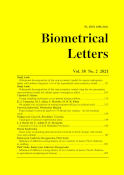
Biometrical Letters Vol. 58(2), 2021, pp. 199-208


A study was carried out to determine the effect of sowing density on the yield of maize of two different varieties. The field experiment was carried out in 2012-2014 at the Department of Agronomy of Poznañ University of Life Sciences. The first-order factor was the variety: SY Cooky and Drim "stay-green"; the second-order factor was sowing density: 6, 7, 8, 9, 10 plants per m2. Weather conditions during the maize growing seasons significantly influenced the values of the studied traits. Significantly the lowest green mass yield of maize was obtained at the sowing density of 6 plants m-2, and the highest for 10 plants m-2. The "stay-green" variety significantly responded to an increase in sowing density with reduced fresh weight of leaf blades of a single plant compared with the conventional variety. This indicated highly effective photosynthesis with a lower plant density per unit area, which is also the basis for effective absorption of solar radiation for these maize varieties.

fresh weight yield, maize, sowing density, split-split-plot design, Tukey's test

